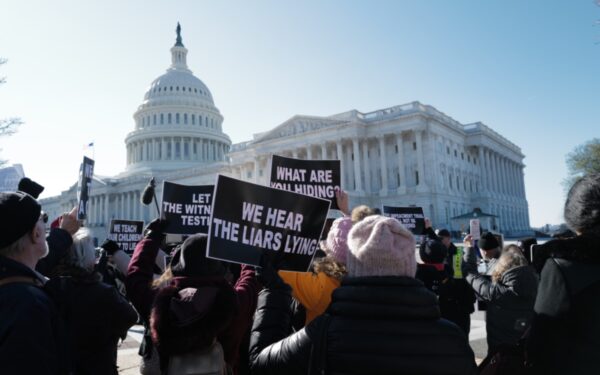It’s known as the “perp walk” and it holds a unique place in American culture. It’s the last act in nearly every mafia movie, as well as providing some of the most iconic moments in the nation’s history. The perp walk (“perp” meaning “perpetrator”) often signals the end of a reign, such as those of Harvey Weinstein over Hollywood and Bernie Madoff over Wall Street. Sometimes it marks the end of a life. It was during his perp walk that Lee Harvey Oswald was shot by Jack Ruby.
The perp walk, described simply, is that moment, usually at the end of a long investigation and (because this is America) even longer trial, when the two sides come together in an orchestrated parade before the cameras. Law enforcement agents usually emerge from an office, a government building, an aircraft, or a home, one on each arm of the person accused of a crime. Flash guns explode. A scrum of press shout questions. The accused looks defiant or ashamed. Usually, there are handcuffs. Sometimes the perp has their head covered. Other times, such as when Steve Bannon was marched before the press last year, they grin into the cameras and offer an impromptu defence.
Yet the walk is less about the legal system and matters of guilt and innocence, as much as it is symbolic of a process being done. It is the formalised version of a spectacle that was once unruly and chaotic, finding its apotheosis in the scenes around the guillotine during the French Revolution where the earlier tradition of punishing criminals privately behind closed doors was turned into a public event. As Michael Foucault noted in Discipline and Punish, “The public execution is to be understood not only as a judicial, but also as a political ritual.”
And that is certainly true in the modern sense of the perp walk. While the walk might give a criminal a chance to boost their profile, it’s really about enhancing the image of the law enforcement officials, many of whom are, in the American system, elected and therefore political. Somewhat ironically, it was Trump acolyte and former New York Mayor, Rudy Giuliani, who made an art form of the perp walk, back when he was the Attorney General of the Southern District and cracking down on organised crime. Giuliani understood the power of the cameras, especially when it came to boosting his profile.
This brings us to Donald Trump and the news that he is apparently eager to be seen doing his own perp walk should the Manhattan district attorney’s office finally decide to indict him on charges of paying off a porn star during his 2016 presidential campaign.
Speculation has raged for weeks as to whether New York prosecutors would decide to arrest a former president. Would special arrangements be made? Rumours have circulated that the Secret Service, still apparently loyal to Trump, is unhappy with the idea of its charge being handcuffed. Yet now it seems that Trump not only wants to walk the walk, but wants to do it in handcuffs. He wants to make it a television spectacle. He wants to be seen.
It would be typical of Trump if he did manage to script his arrest. It would also make sense to get the details right. This will be one of the most iconic moments in American history and, perhaps, the most iconic perp walk bar none. Such is the anticipation that we’re already seeing it happen before it even happens. We are now in the age of AI-created images and social media has been filled with images created in “Midjourney”, a text-to-image generator, of fictionalised (but photographically realistic) images of Trump being dragged into court. In some, he’s standing off against police, in a scrummage of arms and legs. In others, he’s being pepper sprayed.
The power the fake images are already having is a testament to the power that real images will have should Trump be marched in front of the cameras in handcuffs. Yet for Trump himself, his best line of defence is to lean into the prosecution. It represents his best chance for shaping the media narrative in the same way he has done for the past seven years or more. This is especially true given the reluctance of once-loyal channels, such as Fox News, about covering his candidacy. He wants – perhaps needs – to be seen suffering a ritualised humiliation against which he can stand defiant, make a speech about the politicised nature of the allegations, and maintain his complete innocence. It is his chance to play the victim – a role he does so well – and to remind America’s Republican voters that while Florida governor Ron DeSantis may have risen in the polls and is the new favourite of the conservative elite, Democrats don’t fear him as much as they fear Donald J. Trump. Look who they have chosen to prosecute, he’ll say. Look who they are shaming by making him walk handcuffed before their friends in the corrupt press.
The danger for Trump, conversely, is less political and more consequential in that he is in serious legal trouble and there is a non-zero chance that he faces jail time. While it strains the imagination to think any American ex-president could spend time behind bars, it is to be remembered that Michael Cohen, his former “fixer” who made the payments to Stormy Daniels at Trump’s behest, has already served three years in prison, and was disbarred from practising law in New York. Would it seem fair if Trump got away with the same crime? Trump restricted to some private estate for the term of his sentence might make more sense, though perhaps more likely is his prosecution running right into the back of the 2024 election.
And that remains the significant question here. The next week will certainly shift the narrative of the 2024 election in ways we cannot even begin to anticipate. It will thrust Trump back into the limelight, ensure his name is uttered thousands of times an hour across all the news networks, and create a new toxic division across America between those that believe him innocent and those certain of his guilt. Perhaps in a very real, complicated, and utterly surreal sense, the perp walk will properly mark the start of Trump’s 2024 run for the presidency.
Write to us with your comments to be considered for publication at letters@reaction.life




